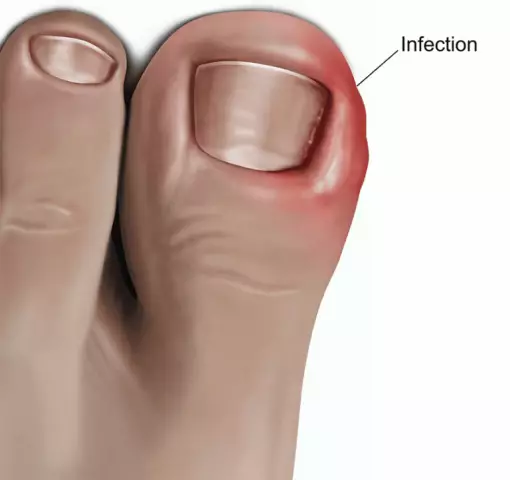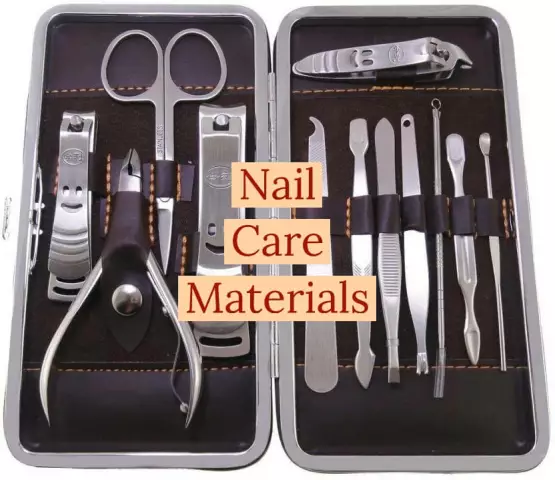- Author Rachel Wainwright [email protected].
- Public 2024-01-15 19:51.
- Last modified 2025-11-02 20:14.
Hand nail contusion: symptoms, first aid, treatment
The content of the article:
- The mechanism of formation of a subungual hematoma
- Types of contusion
- Symptoms
-
What to do with a bruised nail on your hand
- First aid
- Treating a bruised nail
- Traditional medicine
- Recovery period
- Video
A bruise of a fingernail is a fairly frequent and serious injury in which damage to the nail plate and soft tissues of the finger occurs. On clinical symptoms, it may resemble a fracture.

Index and thumb are injured more often than other fingers
Most often, such injuries are received in everyday life, the fingers of the hand suffer from blows from heavy objects or pinching between hard surfaces. Possible damage during sports. In most cases, the index and thumb are injured.
The mechanism of formation of a subungual hematoma
When the nail is bruised, nerves and small vessels are damaged, blood is poured into soft tissues, forming a hematoma. As a result of edema, nerve endings are compressed, of which there are many in this area, this leads to very severe pain. The nail plate is quite dense, because of this, areas of high pressure are created in the tissues, which increases the pain sensation.

The formation of a subungual hematoma as a result of injury is associated with the anatomical features of the structure of the fingers
Fractures, sprains, and diseases that affect the condition of blood vessels and weaken their walls (scurvy, diabetes mellitus) contribute to the appearance of hematomas and bruises under the nails.
Blood becomes the cause of the staining of the nail. It is initially red in color, but a lack of oxygen under the nail plate leads to the rapid destruction of red blood cells and hemoglobin, resulting in a blue color. When the blood dries out in the leaky cavity of the hematoma, the nail becomes black.
Types of contusion
Depending on the severity of the injury, the following degrees of injury are distinguished:
- easy. The damage is minor, in some cases soft tissue is affected. Within a day, the problem disappears on its own;
- moderate severity. The nail plate is damaged, a hematoma occurs in the area of injury (the nail turns blue); if this happens, the plate may peel off in the future;
- heavy. The nail plate is damaged, severe swelling and hemorrhage occurs. Dislocation of the finger can be observed, as well as cracks and bone fractures, the nail plate exfoliates.
Symptoms
As a result of the studies carried out, it was revealed that immediately after mechanical damage to soft tissues in the area of the nail on the arm or leg (without fracture of bones), hyperthermia, redness, swelling and soreness occur. Using infrared thermography, it was found that after 10 seconds, the temperature of the bruised area increased by 1.0-1.5 ° C.
Characteristic signs of a bruise:
- the finger swells, the nail becomes purple or cherry blue. The size and shape of the cyanotic zone depends on the location and strength of the blow;
- the process of hematoma formation is accompanied by pain. As a result of the formation of a high pressure zone, the pain becomes very intense, bursting, twitching.
After 1-2 days, pain decreases, the temperature returns to normal, and the nail becomes blue or blue-black. If the injury is closed, then in most cases the purulent process does not join, but the edema can spread to the entire finger.
The damaged nail grows, and at the same time the dark spot under the nail plate gradually moves. After a while, the color changes to blue, then to black. The damaged nail plate is completely replaced in 1-3 months.
If you fall on a straightened finger or hit the end part, a subcutaneous rupture of the flexor tendons may occur:
| Type of tendon rupture | Description |
| Full | The nail phalanx is fully bent, while there are no extensor movements |
| Incomplete | Flexion is maintained, but full flexion is not possible |
What to do with a bruised nail on your hand
First aid
If there is a ring on the finger, it must be removed first, because in the future, due to the growing swelling, this will not work. In order to avoid the formation of a hematoma, the finger is placed under a stream of cold water, a cold compress or ice is applied to it. This will help to narrow blood vessels and reduce pain. Cold is applied for 10 minutes, then take a break.

In order to exclude a fracture, an X-ray of the injured hand is performed
If abrasions or cuts are detected, they are treated with antiseptics (hydrogen peroxide, Chlorhexidine, Zelenka or Iodine). In case of partial detachment of the nail, the wound is washed, and in order to prevent further injury, a bandage with anesthetic ointment is applied.
For these purposes, use a bandage, gauze or piece of fabric. Do not glue the damaged nail with adhesive plaster, as it will be difficult to remove it in the future. The procedure will be very painful, and if the nail plate has peeled off, it can be torn off completely.
After first aid has been provided, the patient must be taken to the emergency room in order for the doctor to rule out complex injuries, such as fracture or dislocation. You can determine them using X-rays.
Treating a bruised nail
Contusion is treated on an outpatient basis. In the presence of subungual hematomas, they are opened by piercing the nail plate with a needle. Since there are no nerve endings in it, this procedure is not too painful. But with severe bruises, it is possible to administer pain medications.
In order to reduce pain in case of injury, the patient is recommended to use pain relievers based on ketorolac (Ketanov, Ketorol), nimesulide (Nimid, Nimesil, Nimedar) or ibuprofen (Nurofen, Ibuprom). Preparations are taken according to the instructions 2-3 times a day after meals.

In some cases, a plaster cast or fixation bandage is required
In the first hours after the injury, if possible, the limb should be kept elevated. With a subcutaneous tendon rupture, fractures and cracks in the bones, a plaster splint or a fixing bandage is applied to the fingers.
Traditional medicine
The following folk remedies will help to cure a bruise at home:
- recipe number 1: a tablespoon of potato starch is diluted with warm water until the consistency of thick sour cream. The agent is applied to the surface of the finger. After the gruel hardens, it is washed off with warm water and reused. This procedure is carried out until symptoms are relieved;
- recipe number 2: mix one teaspoon of soda and sea salt and dissolve in a glass of warm water. A finger is immersed in the solution and held for a quarter of an hour. Then hydrogen peroxide is applied to the surface. The procedure is carried out daily until the symptoms of bruising disappear;
- recipe number 3: a plantain leaf is washed under running water, a thin layer of honey is applied to its surface, applied to the damaged nail and fixed with a bandage. The compress is left overnight;
- recipe number 4: Badyagi powder is diluted with warm water and applied to the damaged area. Wash off the product after two hours with warm water. The procedure is carried out in the absence of damage to the skin twice a day until symptoms are relieved;
- recipe number 5: finely chop the wormwood herb, apply it to the bruise, cover it with polyethylene on top and fix it with a bandage. The compress is removed after three hours. The procedure is repeated every day until the pain subsides.
Recovery period
During the entire period of rehabilitation, it is necessary to avoid physical exertion on the injured arm.
In cases where, after this period, the injured finger does not extend, surgical intervention may be required.
If within a week after the injury the patient's condition does not improve, the pain intensifies or purulent discharge appears, it is necessary to seek repeated advice from a traumatologist or surgeon in order to exclude the development of complications.
Video
We offer for viewing a video on the topic of the article.

Anna Kozlova Medical journalist About the author
Education: Rostov State Medical University, specialty "General Medicine".
Found a mistake in the text? Select it and press Ctrl + Enter.






